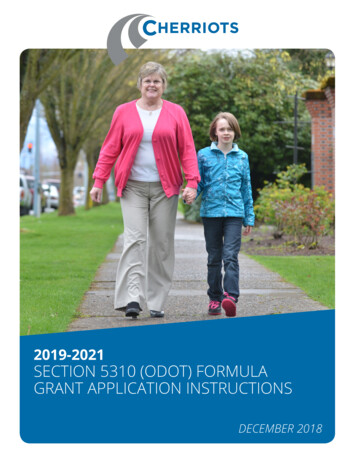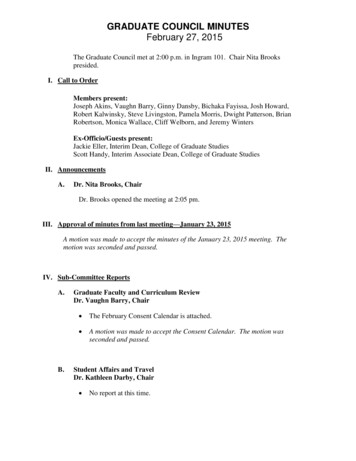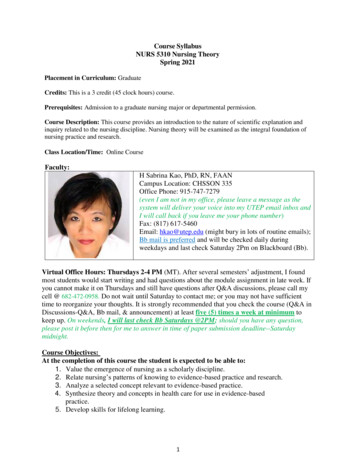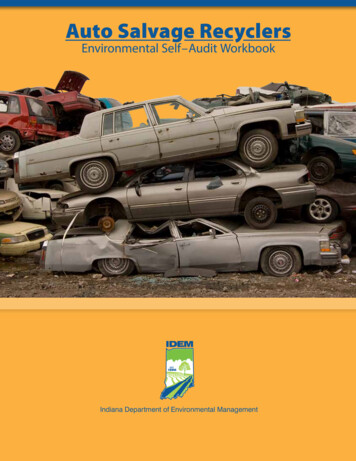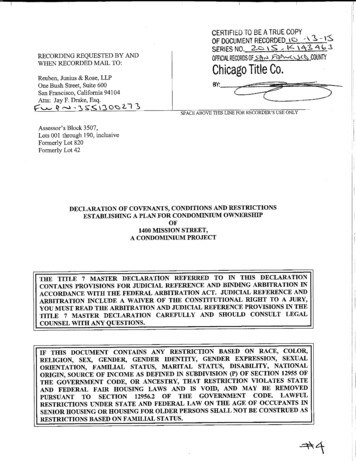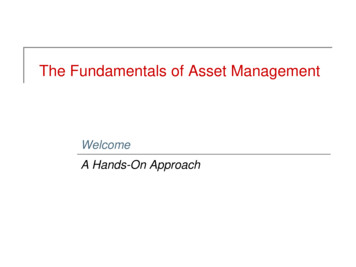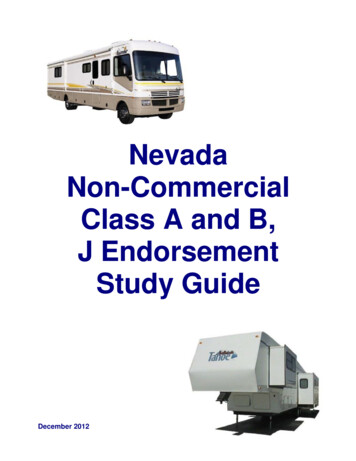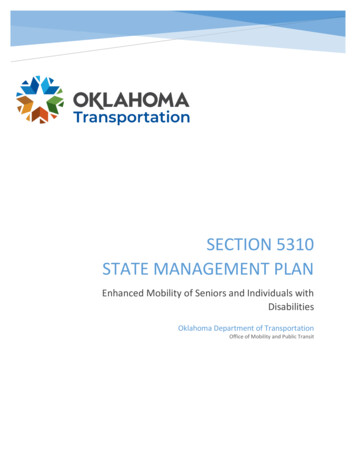
Transcription
SECTION 5310STATE MANAGEMENT PLANEnhanced Mobility of Seniors and Individuals withDisabilitiesOklahoma Department of TransportationOffice of Mobility and Public Transit
Table of ContentsIntroduction . 2Program Goals and Objectives . 2Roles Responsibilities and Coordination . 2Eligible Projects . 8Locally Developed Coordinated Plan/Local Coordinated Plan . 9Eligible Applicants . 10Local Share Requirements . 10Project Selection Process and Method for Funding Distribution . 10Application Process and Timeline . 11Transfer of Funds. 12Oversight of Subrecipients . 13Civil Rights . 16Title VI . 16Equal Employment Opportunity (EEO) . 18Disadvantaged Business Enterprise (DBE) . 19Section 504 and ADA Reporting . 22Program Measures . 24Financial Management . 24Procurement . 27Property Management and Disposition . 31Transit Asset Management (TAM). 35Other Provisions . 35Annual Certifications and Assurances . 36Drug and Alcohol Testing Program . 36Charter Rule . 36School Bus Operations . 37Private Sector Participation . 37Grievance Procedures . 37Additional Provisions . 381
INTRODUCTIONThe Federal Transit Administration (FTA) is one of ten operation administrations within the U.S.Department of Transportation (USDOT). USDOT through FTA provides financial assistance to statesand local government entities to develop new transit systems, and improve, maintain, and operate existingsystems. Funding is also made available to Regional Transportation and Metropolitan PlanningOrganizations (MPO), local and tribal governments and Transit Providers for eligible transit activities.FTA oversees, and ensures regulatory compliance of transit funds awarded to States and requires eachstate to have an approved State Management Plan (SMP) in place. The SMP outlines the state’s policiesfor the administration of FTA’s 49 U.S.C. Section 5310 Program. FTA mandates amendment/revisionsto the SMP with changing legislation and state statues/policies. A significant change to the SMP requiresFTA review and approval.The Oklahoma Department of Transportation (ODOT) was designated by Oklahoma’s Governor for theadministration of federal public transportation financial assistance programs for the State. The intent ofthis document is to outline the state’s policies, procedures, and administrative guidelines for FTA’s 49U.S.C. Section § 5310 Grant Program.Prior to submitting the State Management Plan to FTA, a draft of the document was circulated andcomments were solicited among stakeholders and the public. Emailed, verbal, and written comments wereaccepted. All public comments were recorded in a Public Comment Inventory spreadsheet along withinformation about the disposition of each. The Public Comment Inventory is available upon request.PROGRAM GOALS AND OBJECTIVESThe goal of the Section 5310 program is to improve mobility for seniors and individuals with disabilitiesthroughout the country by removing barriers to transportation services and expanding thetransportation mobility options available. The program provides financial assistance for transportationservices including: Public transportation projects planned, designed and carried out to meet the special needs ofseniors and individuals with disabilities when public transportation is insufficient, inappropriateor unavailable;Public transportation projects that exceed the requirements of the Americans with DisabilitiesAct (ADA);Public transportation projects that improve access to fixed-route service and decreasereliance on complementary paratransit; andAlternatives to public transportation projects that assist seniors and individuals withdisabilities with transportation.ROLES, RESPONSIBILITIES AND COORDINATIONGrantees of federal and state funding are required to comply with all federal and state programrequirements, including the submission of requested information and regular reports to documentcompliance and measure project performance. Compliance reviews, including on-site visits to monitorproject performance, are conducted by ODOT.The Federal Transit Administration:The Federal Transit Administration (FTA) is the federal oversight agency headquartered in Washington,D.C. FTA’s responsibilities include, but are not limited to: providing policy and program guidance,2
funding allocation to the States; developing and implementing financial management procedures;providing program support; and conducting state management reviews, an evaluation/audit that occursevery three years or as warranted; reviewing and approving grant applications; reviewing and approvingSMPs. The day to day administrations of Oklahoma’s programs are managed by FTA’s Region VI officelocated in Fort Worth, Texas. FTA headquarters contact information is as follows:Federal Transit AdministrationOffice of Communications and Congressional Affairs1200 New Jersey Avenue SE, East BuildingWashington, DC 20590Phone: 202-366-4043Oklahoma Department of Transportation – Office of Mobility and Public Transit (OMPT):ODOT is the Governor's designee responsible for the administration of FTA’s Formula Grants, StateSafety Oversight Program and related state funded public transit activities as promulgated under Title730, Chapter 45 of the Oklahoma Administrative Rules and Title 69 of the Oklahoma Statue (as amended),and has assigned ODOT’s Office of Mobility and Public Transit (OMPT) with the administration of theseactivities. ODOT may additionally enter into agreements with qualified entities and/or contractors tocarry out these activities as deemed necessary. OMPT will fulfill ODOT’s obligation by: As allowed by FTA C 9070.1G ODOT will allocate up to 10% of the 5310 program apportionmentat 100% federal match for program administrationDeveloping a fair and equitable application process for the distribution of available FTA fundingto eligible large urban, small urban, rural, and tribal transit agenciesNotifying eligible subrecipients, soliciting applications annually and submitting an annualprogram of projects and grants to FTACertify eligibility of applicants and project activitiesEntering into agreement with FTA funded subrecipients and applicable contractorsMonitoring subrecipients programs to ensure compliance with FTA rules and regulationsProviding technical support and assistance for subrecipientsOverseeing subrecipient project audits and closeoutAuditing submitted subrecipient reimbursement claims for FTA funding eligibilitySubmitting all FTA reports for ODOT and its subrecipients as required by FTAProvide coordination of public transportation services funded by FTA with transportation servicesaided by other federal programsEnsuring coordination of public transit at the state and local levels. Oklahoma does not have astate process for intergovernmental review of federal programs, therefore FTA Grant Programsare not submitted to a state clearinghouse for review. However, all FTA funded projects areincluded as an element of ODOT's Statewide Transportation Improvement Program (STIP) andthereby will go through the STIP review processCompiling and updating the Statewide Transportation Improvement Program (STIP) for FederalHighway Administration (FHWA) and Federal Transit Administration (FTA) approval. TheSTIP includes the Transportation Improvement Program (TIP) from the Metropolitan PlanningOrganizations (MPOs)Assigning project numbers for all OMPT projectsRequiring that applicants for FTA funded programs, when applicable, provide documentation tosupport their efforts to coordinate proposed transportation services with both private for profitand nonprofit service operators. Acceptable documentation will include, but not limited to: An3
executed coordination agreement, written and published invitations, public announcements, signin sheets and notes of public forums, etc.ODOT General Counsel Division:The General Counsel Division’s responsibility includes but is not limited to providing legal counsel,reviewing and approving the OMPT’s subrecipient agreements and contracts.ODOT Comptroller Division:The Comptroller Division is responsible for the following: Review and approval of OMPT’s annual budgets. Processing OMPT approved claims of subrecipients. Reconciling submitted claims with OMPT before and after each Electronic Clearing HouseOperation (ECHO). Review and approve FTA reports and grant closeouts prior to submission by OMPT. Review and submit OMPT related reports in compliance with the Federal Funding AccountabilityTransparency Act (FFATA) reporting requirements.ODOT Operations Review and Evaluation Division (OR&E):The OR&E Division is responsible for the review of subrecipient’s single audits for compliance with Officeof Management and Budget (OMB) and examines annual audit reports from the Oklahoma State Auditorand Inspector’s Office.ODOT Civil Rights Division:The Civil Rights Division is responsible for the following: Conducting/developing required Disadvantaged Business Enterprise (DBE) goal methodologyprocess and the establishment of subsequent goals Conducting disparity studies ADA compliance and oversight of complaint process Providing DBE training, outreach and partnerships Conducting DBE certification process and maintaining certified DBE directory Review FTA civil right reports for accuracy before submission by OMPT to FTA Review of OMPT associated civil right plan templets for subrecipients ODOT’s Title VI compliance procedures Policy for which ODOT’s Title VI certification is basedODOT Procurement Division:The Procurement Division is tasked with the administration/oversight of the Departments procurementdemands, including but not limited to the procurement of professional goods and services to ensurecompliance with state and federal regulations. Review OMPT capital procurement bid documents and submit to the Office of Management andEnterprise Service’s (OMES) Central Purchasing Division for solicitation. Provide subrecipient claim account information for reimbursements.ODOT Human Resources Division:The Human Resources Division is responsible for the oversight of ODOT staffing to include, but notlimited to: Ensuring that required State and Federal hiring standards/practices are followed when staffingOMPT4
ODOT Drug and Alcohol awareness programsODOT required State and Federal employee training programsODOT Environmental Division:The Environmental Division is responsible for the following: To integrate environmental considerations and regulatory requirements into ODOT’stransportation programs and operations; To provide a broad range of technical expertise in the natural and human environment; To provide environmental (NEPA) documents and permits for ODOT projects and activities; and To liaise with regulatory agencies to streamline the environmental review and permit processes.ODOT Office of Research and Implementation (ORI):The ORI is responsible for the following: Establishes and facilitates the process to identify, select, program, manage, and deploy research. Meets all federal-aid program requirements. Establishes the research agenda based on the involvement and participation of ODOT. Develops and performs applied transportation research for all modes of transportation. Provides technical assistance to ODOT to implement transportation research products. Engages in both short-term and long-term research. Allocates funding for the research that includes leveraging national research funding from othertransportation organizations and pooled funding opportunities.ODOT Strategic Asset and Performance Management:It is the responsibility of Strategic Asset and Performance Management to coordinate the StatewideTransportation Improvement Program (STIP) and the Transportation Improvement Program (TIP) forthe state of Oklahoma.ODOT Subrecipients:Subrecipients receiving State and FTA funds must possess the technical capacity necessary to manage allaspects of the associated transit grant program(s) and comply with established program requirements toinclude, but not limited to: The ability to maintain financial, technical, managerial and legal capacity to oversee a transitserviceOrganizational planningCompliance with and monitoring of all civil rights requirementsThe ability to enter into contractual agreement(s) with ODOTAttending program trainings and participating in meetings as appropriateMaintaining transit assets in a state of good repairStaying current with FTA program circulars, the ODOT State Management Plan, and 5310program requirementsSubrecipients of program funding must provide documentation to support their efforts to locallycoordinate their proposed transportation services with other public and tribal transportation providers.This includes both private for profit and nonprofit operators. Efforts to accomplish this would include,but not be limited to, written invitations, published invitations, public announcements, sign-in sheets, andnotes of public forums. Detailed responsibilities for associated grant programs are outlined in associatedapplication documents.5
Coordination - In order to receive funding through this program, projects must be included in a locallydeveloped, coordinated public transit-human services transportation plan. ODOT OMPT provides technicalassistance to lead agencies, including but not limited to metropolitan planning organizations (MPOs),boards of county commissioners, transit agencies, and community action agencies, in developing andupdating these coordination plans.Maintenance - Proper maintenance of assets is key to protecting the FTA investment and prolonging theuseful life of the asset. All subrecipients must have a written maintenance plan(s) for FTA-funded assets.These plans must describe a system of periodic inspections and preventive maintenance to be performedat certain defined intervals. Plans should be updated with the purchase of new rolling stock to account fornew technology and/or new manufacturer’s recommended maintenance intervals and programs, andincorporate actions to maintain each vehicle type and model on a specific cycle. These actions will helpensure proper care and maximize vehicle longevity.A model program for FTA-funded vehicles and associated accessories would include, but not be limitedto: An organization and assignment of responsibility for vehicle, facilities and associated accessorymaintenance A system of periodic inspections and preventive maintenance to be performed at certain definedintervals (required in regulation). Such a system may be part of a subrecipient’s maintenancemanagement information system. Maintenance intervals might be measured in terms of time(daily, monthly, or annually) or in terms of use (hours) A record-keeping system that maintains adequate permanent records of maintenance andinspection activity for vehicles and associated accessoriesOklahoma State Office of Management and Enterprise Service’s (OMES) Central PurchasingDivision:The Central Purchasing Division is responsible for oversight of the solicitation/procurement process forcapital assets to include, but not limited to: Registering and reviewing past performances of vendors Ensuring a competitive process for proposals to solicit bids for statewide contract for transitvehicles and equipment Ensuring that specifications and bid packets meet federal and state requirements Ensuring that bid awards meet all federal and state regulations Maintenance of the statewide procurement websiteMetropolitan Planning Organizations:ODOT currently coordinates planning efforts with four Metropolitan Planning Organizations (MPOs)as follows: Association of Central Oklahoma Governments (ACOG)http://www.acogok.org/Address: 4205 N. Lincoln Boulevard, Oklahoma City, Oklahoma 73105Phone: 405.234.2264Email: acog@acogok.org Indian Nations Council of Governments (INCOG)http://www.incog.org/Address: 2 West Second St., Suite 800, Tulsa, OK 74103Phone: 918.584.75266
Fax: 918.583.1024Email: incog@incog.org Lawton Metropolitan Planning Organizations (LMPO)http://www.lawtonmpo.org/Address: 212 Southwest 9th St., Lawton, OK 73501Phone: 580-581-3375 Frontier Metropolitan Planning Organization (Frontier)http://www.frontiermpo.org/Address: 1109 N. 16 St., Fort Smith, AR 72901Phone: (479) 785-2651Coordination must occur between the MPOs and local transit providers with respect to service areas.Subrecipient coordination efforts are reviewed by ODOT as part of the program application process.Proposed FTA funded projects within the MPO regional transportation planning boundaries must beincluded in the MPO’s Transportation Improvement Program (TIP) and subsequently in ODOT’sStatewide Transportation Improvement Program (STIP).Statewide Transportation Improvement Program (STIP):The STIP is a financially constrained program which identifies priority and regionally significanttransportation projects based on extensive planning. These are projects in which full funding is reasonablyanticipated to be available in order to implement during the next four (4) years. This is not a final scheduleof projects but is a "best estimate" at the time of STIP development. The STIP serves as a short rangeplanning tool which educates the public on future transportation needs and assures that federal funds arespent on projects consistent with approved long range plans. The State's procedures for developing theProgram of Projects are outlined in the STIP and it includes four (4) program years.All federal funds programmed for highway or transit projects must be included in a STIP. For the purposeof the STIP, the state may aggregate its planned expenditures of FTA funded programs into statewideprojects. These funds may then be used for items such as vehicle acquisition for rural and small urbantransportation services, statewide planning, state administration, and training and technical assistance.MPOs are responsible for transportation planning and programming in metropolitan areas. If asubrecipient is proposing services within an MPO's planning/study urbanized boundaries, or if the areais expected to become urbanized within twenty years, these services must be included in the MPO'sTransportation Improvement Program (TIP) and the STIP.The Section 5310 program (49 U.S.C. 5310) provides formula funding to states for the purpose of assistingprivate nonprofit groups in meeting the transportation needs of seniors and people with disabilities whenthe transportation service provided is unavailable, insufficient, or inappropriate to meeting these needs.Funds are apportioned based on each state’s share of the population for these two groups. Formula fundsare apportioned to direct recipients; for rural and small urban areas, this is the state Department ofTransportation, while in large urban areas, a designated recipient is chosen by the governor. ForOklahoma, the governor’s designee for large urban areas is also the Department of Transportation.The program aims to improve mobility for seniors and individuals with disabilities by removing barriersto transportation service and expanding transportation mobility options. This program supportstransportation services planned, designed, and carried out to meet the special transportation needs ofseniors and individuals with disabilities in all areas – large urbanized areas (over 200,000 general7
population), small urbanized areas (50,000-200,000 general population), and rural areas (under 50,000general population). Eligible projects include both “traditional” capital investment and “nontraditional”capital investment beyond the Americans with Disabilities Act (ADA). FTA’s guidance and instructions forthis program can be found in FTA C 9070.1G, Chapter III.ELIGIBLE PROJECTSThe 5310 Program funds capital assistant projects only, with the goal in mind of providing transportationservices for all 77 counties in Oklahoma. Applications are accepted during the annual application cycle asannounced by ODOT.Pursuant to federal law, a minimum of 55 percent of each Section 5310 apportionment (large urbanapportionment, small urban apportionment, and rural apportionment) must be used to support traditionalprojects that are planned and designed to meet the special needs of seniors and individuals with disabilities,and are carried out by eligible entities. Traditional projects are limited to include transit ADA vehicles,associated options/start-ups (such as vehicle, wheelchair lifts, ramps, signs, tags, tax and titles etc.), andcapital mobility management projects.Capital mobility management projects consist of short-range planning and management activities andprojects for improving coordination among public transportation and other transportation serviceproviders carried out by an eligible entity through an agreement entered into with other FTA programsubrecipients, including a government entity, under 49 U.S.C. Chapter 53 (other than Section 5309).Mobility management does not include operating public transportation services.Mobility management projects must be for services provided across entities in a coordinated manner andnot perform a function solely for one agency/organization. Mobility management projects are not foroperating transportation services.Capital items such as computer software, call center equipment, and dispatch equipment, intended tosupport mobility management, are categorized as a mobility management project type. Successfulapplicants are responsible for: The entire project cost up-front and request reimbursement of the federal share monthly foreligible expenses; Complying with applicable federal, state, and local rules and regulations as well as applicable andreporting requirements. When applicable, to perform as a Lead Agency for a 5310 coordinated plan for aproposed project service area. A lead agency coordinate transportation servicesfunded by multiple federal or state human service programs.Up to 45 percent of the remaining program funds may be used to support enhanced transportation projects.Enhanced transportation projects are those that exceed the requirements of the ADA, improve access tofixed-route service, decrease reliance by individuals with disabilities on complementary paratransit orprovide alternatives to public transportation that assist seniors and individuals with disabilities. Enhancedtransportation projects may include improving signage and improving access to sidewalks and crosswalks.8
Example Project Types and CategoryNotes: Procurement for eligible activities shall be purchased from State Contract SW-000(as amended)or by a procurement method approved in writing by ODOT’s OMPT to be eligible forreimbursement.Project Type(s)Vehicle her lity ManagementTraditionalorEnhancedEligible ActivitiesPurchase transit vehicles from state contractBenches, Shelters & Passenger AmenitiesIntelligent Transportation System (ITS) planningand technology such as an Automatic Vehicle LocatorSystem (AVL); Mobile Data Terminals (MDT); and/or a Dispatch SystemRadio EquipmentVehicle Rehabilitation or OverhaulComputer Hardware and Software, PreventativeMaintenanceVehicles or equipment designed toaccommodate oversized mobility aids beyondADA requirementsCoordination of services for 5310 target populationsITS planning and technology directly supporting aMobility Management Project, such as a callcenter; or a coordination and dispatch computersystem.Support to plan and implement coordinated servicesLOCALLY DEVELOPED COORDINATED PLAN / LOCAL COORDINATED PLANTo be considered for funding award, proposed projects must be included in a locally developed,coordinated public transit-human service transportation plan. Applicants are required to commit tocoordinate their transportation services as outlined in their locally developed, coordinated public transithuman service transportation plan covering their area of existing/proposed service.Updated or amended Local Coordinated Plans must be submitted to ODOT no less than every four (4)years. Plans older than four (4) years, or those that have not been updated within the last four (4) yearsare considered outdated. An example of entity lead plan development includes but are not limited to: Urbanized areas (over 50,000 in population), the Metropolitan Planning Organization (MPO)Rural areas, the county planning officeMembers of the public, including but not limited to, seniors, individuals with disabilities, representativesof the public, private, not-for-profit transportation and human service providers must participate in thedevelopment and approval of the locally developed coordinated plan.Project Usage Exclusions School Usage Exclusion - School bus purchases are not available through the 5310 program. The useof FTA funds for school bus transportation operations (exclusively for the transportation of studentsand school personnel) is prohibited under Title 49 USC 5323 unless the subrecipient has been grantedan exemption by FTA (See 49 CFR 605.11). Exempted organizations applying for funding mustprovide a copy of the exemption with the application.9
Regardless of the applicant’s exemption status, vehicles purchased through this program may notprovide exclusive school bus service in competition with private school bus companies.An organization may use vehicles purchased through this program for the transportation of studentsand school personnel in incidental charter-bus operations. Sectarian Organizations/Religious Purpose use - Private not-for-profit organizations affiliated withreligious organizations may be eligible for this program, however vehicles purchased through thisprogram cannot be used for religious purposes. For example, vehicles cannot be used to transportmembers of a church or its congregation to the church facility exclusively for religiouspurposes/services.ELIGIBLE APPLICANTSEligible applicants include: Private not-for-profit corporations (can apply for traditional and enhanced projects);Public agencies able to certify to the Governor that no private not-for-profits are readily availableto provide the proposed service (are eligible to apply for traditional projects);All public agencies and operators of public transportation services (are eligible to apply forenhanced projects);Federally recognized Indian entities (are eligible to apply for traditional and enhanced projects);andPrivate companies providing shared-ride services to the general public on a regular basis (areeligible to apply for enhanced projects).Applicants must participate in local public transit/human services
accepted. All public comments ere recorded in a Public Comment Inventory spreadsheet along with w information about the disposition of each. The Public Comment Inventory is available upon request. PROGRAM GOALS AND OBJECTIVES The goal of the Section 5310 program is to improve mobility for seniors and individuals with disabilities
